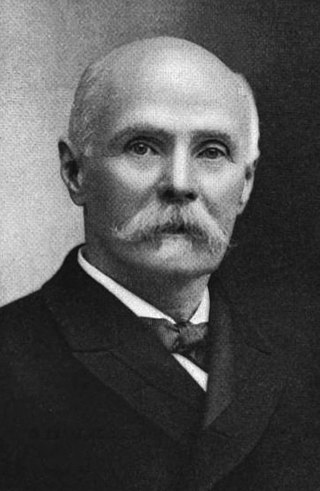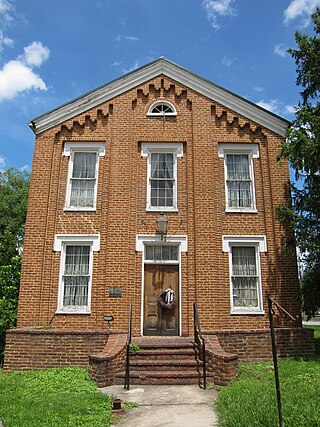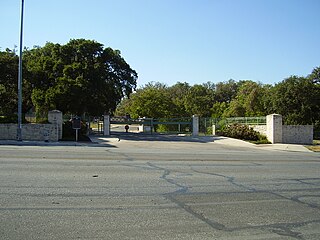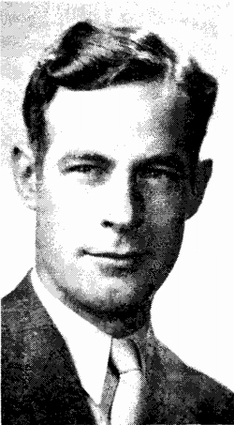
Hampshire County is a county in the U.S. state of West Virginia. As of the 2020 census, the population was 23,093. Its county seat is Romney, West Virginia's oldest town (1762). The county was created by the Virginia General Assembly in 1754, from parts of Frederick and Augusta Counties (Virginia) and is the state's oldest county. The county lies in both West Virginia's Eastern Panhandle and Potomac Highlands regions.

Romney is a town in and the county seat of Hampshire County, West Virginia, United States. The population was 1,722 at the 2020 census. It is part of the Winchester, Virginia metropolitan area. Established in 1762 along with Shepherdstown, they are the oldest towns in West Virginia.
Perkins School for the Blind, in Watertown, Massachusetts, was founded in 1829 and is the oldest school for the blind in the United States. It has also been known as the Perkins Institution for the Blind.

Indian Mound Cemetery is a cemetery located along the Northwestern Turnpike on a promontory of the "Yellow Banks" overlooking the South Branch Potomac River and Mill Creek Mountain in Romney, West Virginia, United States. The cemetery is centered on a Hopewellian mound, known as the Romney Indian Mound. Indian Mound Cemetery is also the site of Fort Pearsall, the Confederate Memorial, Parsons Bell Tower, and reinterments from Romney's Old Presbyterian Cemetery. The cemetery is currently owned and maintained by the Indian Mound Cemetery Association, Inc.

Ohio State School for the Blind is a school located in Columbus, Ohio, United States. It is run by the Ohio Department of Education for blind and visually impaired students across Ohio. It was established in 1837, making it the nation's first public school for the visually impaired.

The California School for the Blind is a public educational institution for blind children, K-12, located in Fremont, California. Its campus is located next to the California School for the Deaf.

Robert White was an American military officer, lawyer, and politician in the U.S. state of West Virginia. White served as Attorney General of West Virginia (1877–1881) and served two terms in the West Virginia House of Delegates, representing Ohio County in 1885 and 1891.

Kansas State School for the Blind (KSSB) is a fully accredited public high school located in Kansas City, Kansas, U.S., serving students in grades Pre-K through 12. The school was established in 1867. It is located on 10 acres (40,000 m2) located in downtown Kansas City, Kansas. It opened its doors in May, 1868 and admitted the first five students.

Literary Hall is a mid-19th-century brick library, building and museum located in Romney, a city in the U.S. state of West Virginia. It is located at the intersection of North High Street and West Main Street. Literary Hall was constructed between 1869 and 1870 by the Romney Literary Society.

Texas School for the Deaf (TSD) is a state-operated primary and secondary school for deaf children in Austin, Texas. Opened in 1857 "in an old frame house, three log cabins, and a smokehouse", it is the oldest continually-operated public school in Texas. The school struggled under inadequate funding during the American Civil War, and its aftermath, with the students eating food that they grew themselves on the school farm. In 1951 the State Board of Education assumed oversight of the school.

The New Mexico School for the Blind and Visually Impaired is a state special education school with a residential campus in Alamogordo, New Mexico and a preschool in Albuquerque, New Mexico. It operates outreach programs throughout the state.

The Alabama Institute for Deaf and Blind (AIDB) is the world’s most comprehensive education, rehabilitation and service program serving individuals of all ages who are deaf, blind, deafblind and multidisabled. It is operated by the U.S. state of Alabama in the city of Talladega. The current institution includes the Alabama School for the Deaf, the Alabama School for the Blind, and the Helen Keller School of Alabama, named for Alabamian Helen Keller, which serves children who are both deaf and blind. E. H. Gentry Facility provides vocational training for adult students, and the institution offers employment through its Alabama Industries for the Blind facilities in Talladega and Birmingham. AIDB has regional centers in Birmingham, Decatur, Dothan, Huntsville, Mobile, Montgomery, Opelika, Shoals, Talladega, and Tuscaloosa. AIDB currently serves over 36,000 residents from all 67 counties of the state.

John Rinehart Blue was an American military officer, educator, businessperson, and politician in the U.S. state of West Virginia. Blue was a Democratic member of the West Virginia House of Delegates representing Hampshire County, from 1953 until 1959.
Romney Academy was an educational institution for higher learning in Romney, Virginia. Romney Academy was first incorporated by the Virginia General Assembly on January 11, 1814, and was active until 1846 when it was reorganized as the Romney Classical Institute. In addition to the Romney Classical Institute, Romney Academy was also a forerunner institution to Potomac Seminary. Romney Academy was one of the earliest institutions for higher learning within the present boundaries of the state of West Virginia.

John Collins Covell was a 19th-century American educator and school administrator specializing in deaf education in the U.S. states of Virginia and West Virginia.

Henry Bell Gilkeson was an American lawyer, politician, school administrator, and banker in West Virginia.

Howard Hille Johnson was a blind American educator and writer in the states of Virginia and West Virginia. Johnson was instrumental in the establishment of the West Virginia Schools for the Deaf and Blind in 1870, after which he taught blind students at the institution's School for the Blind for 43 years.
Romney Classical Institute was a 19th-century coeducational collegiate preparatory school in Romney, Virginia, between 1846 and shortly after 1866. Romney had previously been served by Romney Academy, but by 1831 the school had outgrown its facilities. The Virginia General Assembly permitted the Romney Literary Society to raise funds for a new school through a lottery. On December 12, 1846, the assembly established the school and empowered the society with its operation.

The Romney Literary Society existed from January 30, 1819, to February 15, 1886, in Romney, West Virginia. Established as the Polemic Society of Romney, it became the first organization of its kind in the present-day state of West Virginia, and one of the first in the United States. The society was founded by nine prominent men of Romney with the objectives of advancing literature and science, purchasing and maintaining a library, and improving educational opportunities.
Texas Blind, Deaf, and Orphan School was a school for blind and deaf black people in Austin, Texas. Throughout its history, due to educational segregation in the United States, the school served only black students and had black teachers; whites attended the Texas School for the Deaf (TSD) and the Texas School for the Blind and Visually Impaired (TSBVI).
































